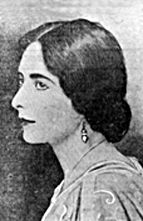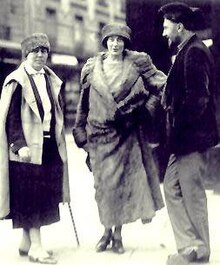Mina Loy
Mina Loy | |
|---|---|
 Mina Loy in 1917 | |
| Born | Mina Gertrude Löwry 27 December 1882 London, England |
| Died | 25 September 1966 (aged 83) |
| Occupation(s) | Writer: poet, playwright, novelist; actress, designer |
| Movement | Modernism, futurism |
Mina Loy, born Mina Gertrude Löwy (27 December 1882 – 25 September 1966), was a British artist, writer: poet, playwright, novelist, futurist, feminist, designer of lamps, and bohemian. She was one of the last of the first generation modernists to achieve posthumous recognition. Her poetry was admired by T. S. Eliot, Ezra Pound, William Carlos Williams, Basil Bunting, Gertrude Stein, Francis Picabia and Yvor Winters, among others.
Personal life
Loy was born in London. In 1899 she changed her name from Mina Gertrude Löwy to Mina Loy. Loy was married twice. On 31 December 1903, she married Stephen Haweis. Their marriage ended in 1913. She married Arthur Cravan in Mexico City in 1918. Not long after their marriage, Cravan was lost at sea without trace;[1] although some mistakenly claim that his body was found later in the desert.[2] She had four children; three by her first husband, Haweis; and one by her second husband, Cravan. Her children by Haweis were: Oda Janet Haweis (1903 - 1904), Joella Synara Haweis Levy Bayer (1907 - 2004) and John Giles Stephen Musgrove Haweis (1909 -1923). Her only child with Cravan was called Jemima Fabienne Cravan Benedict (1919 -1997).
Writing
Loy's poetry was published in several magazines before being published in book-form. Some of the magazines that she was featured in include: Camera Work, Trend and Rogue. Loy had two volumes of her poetry published in her lifetime: The Lunar Baedeker (1923) and The Lunar Baedeker & time-tables (1958). Posthumously, two updated volumes of her poetry were released, The Last Lunar Baedeker (1985) and The Lost Lunar Baedeker (1997), both edited by Roger L. Conover. She also wrote two screenplays: The Sacred Prostitute (1914) and Parturition (1914). She wrote a novel, Insel, which was also published posthumously, in 1991.
Feminist Manifesto
In 1914, while living in an expatriate community in Florence, Italy, Loy wrote the Feminist Manifesto, for which she is perhaps best known today. The manifesto begins with a direct call on women:[3]
The feminist movement as at present instituted is Inadequate. Women if you want to realize yourselves-you are on the eve of a devastating psychological upheaval-all your pet illusions must be unmasked—the lies of centuries have got to go—are you prepared for the Wrench—? There is no half-measure—NO scratching on the surface of the rubbish heap of tradition, will bring about Reform, the only method is Absolute Demolition. Cease to place your confidence in economic legislation, vice-crusades & uniform education-you are glossing over Reality. Professional & commercial careers are opening up for you—Is that all you want ?
A galvanising polemic against the subordinate position of women in society, the short text remained unpublished in Loy's lifetime.
Return to Europe and New York

Loy would return to Florence and her other children. However, in 1916 she moved to New York. While in New York, she worked in a lamp-shade studio, as well as acting in the Provincetown Theater. Here she returned to her old Greenwich Village life, perusing theatre or mixing with her fellow writers. She would mingle and develop friendships with the likes of Ezra Pound, Dadaist Tristan Tzara, and Jane Heap. Tzara in most accounts in 1916 was involved in founding Zurich Dada; Loy did contribute writing to Marcel Duchamp's two editions of The Blind Man.
In 1923, she returned to Paris. Her first volume of poetry, Lunar Baedecker was published this year. Despite doing well in her literary career, she continued to provide for her family through the manufacture and design of lampshades, which she was creating for the shop that she opened with financial backing from Peggy Guggenheim. Loy also picked up old friendships with Djuna Barnes and Gertrude Stein. In the early 1930s, while still living in Paris, Loy began writing Insel, a künstlerroman that fictionalises her friendship with German surrealist painter Richard Oelze, a friendship begun in part because Loy was the Paris agent for her son-in-law Julien Levy's New York gallery. Loy drafted and revised Insel until 1961, when she unsuccessfully sought its publication. The novel was finally published by Black Sparrow Press in 1991, edited by Elizabeth Arnold.[4]
Later life and work
In 1936, Loy returned to New York and lived for a time with her daughter in Manhattan. She moved to the Bowery, where she became interested in the Bowery bums, writing poems and creating found art collages on them. In 1946, she became a naturalised citizen of the United States. Her second and last book, Lunar Baedeker & Time Tables, appeared in 1958. She exhibited her found art constructions in New York in 1951 and at the Bodley Gallery in 1959. In 1953, Loy moved to Aspen, Colorado, where her daughters Joella and Jemima were already living; Joella, who had been married to the art dealer of Surrealism in New York, Julien Levy, next married the Bauhaus artist and typographer Herbert Bayer. In Colorado, Mina Loy continued to write and work on her junk collages up to her death, from pneumonia, at the age of 83, in Aspen.
Loy and Arthur Cravan

Disillusioned with the macho elements in Futurism and its move towards Fascism, as well as desiring a divorce from her husband Stephen Haweis, Loy left her children with a nurse and moved to New York in 1916, where she began acting with the Provincetown Players. She was a key figure in the group that formed around Others magazine, which also included Man Ray, William Carlos Williams, Marcel Duchamp, and Marianne Moore. She also became a Christian Scientist during this time. Loy soon became a leading member of the Greenwich Village bohemian circuit. She also met the 'poet-boxer' Arthur Cravan, self-styled Dadaist and fugitive from conscription. Cravan fled to Mexico to avoid the draft; when Loy's divorce was final she followed him, and they married in Mexico City. Here, they lived in poverty, and years later, Loy would write of their destitution.
Once Loy became pregnant, the couple realised they needed to leave Mexico. A few months later, Cravan set sail for Buenos Aires in a small yacht and disappeared without a trace. The tale of his disappearance is strongly anecdotal, as recounted by Loy's biographer, Carolyn Burke. Their daughter was born April 1919.
In a chapter of her memoir entitled "Colossus", Loy writes about her relationship with Cravan, who was introduced to her as "the prizefighter who writes poetry".[5] Irene Gammel argues that their relationship was "located at the heart of avant-garde activities [which included boxing and poetry]".[6] Loy draws on the language of boxing throughout her memoir to define the terms of her relationship with Cravan.[7]
Notes
- ^ Parmar, Sandeep, Mina Loy’s ‘Colossus’ and the Myth of Arthur Cravan, Jacket 34, October 2007
- ^ Rainey, Lawrence (2005). Modernism: An Anthology. Malden, MA, United States of America: Blackwell Publishing. p. 417. ISBN 978-0-631-20448-0.
- ^ http://oncomouse.github.io/loy/feminist.html
- ^ Arnold, Elizabeth (1991). "Afterword" Insel. By Mina Loy. Santa Rosa: Black Sparrow Press. ISBN 978-0-87685-853-0
- ^ Loy cited in Gammel, Irene (2012), "Lacing up the Gloves: Women, Boxing and Modernity". Cultural and Social History 9.3, p. 379.
- ^ Gammel 2012, p. 380
- ^ Gammel 2012, pp. 379–81
References
- Burke, Carolyn. Becoming Modern: The Life of Mina Loy. New York: Farrar, Straus and Giroux, 1996.
- Gammel, Irene. "Lacing up the Gloves: Women, Boxing and Modernity." Cultural and Social History 9.3 (2012): 369–390.
- Kouidis, Virginia. Mina Loy: American Modernist Poet. Baton Rouge: Louisiana State UP, 1980.
- Kuenzli, Rudolf. Dada (Themes and Movements). Phaidon Press, 2006. [Includes poetry by Mina and her relationship to several artists.]
- Loy, Mina. The Lost Lunar Baedeker. Selected and ed. Roger Conover. 1996.
- –––, and Julien Levy. Constructions, 14–25 April 1959. New York: Bodley Gallery, 1959. OCLC 11251843. [Solo exhibition catalogue with commentary.]
- Lusty, Natalya. "'Sexing the Manifesto: Mina Loy, Feminism and Futurism'",Women: A Cultural Review, 19:3, pp245-260. 2008.
- Prescott, Tara. "'A Lyric Elixir': The Search for Identity in the Works of Mina Loy." Claremont Colleges, 2010.
- Shreiber, Maeera, and Keith Tuma, eds. Mina Loy: Woman and Poet. National Poetry Foundation, 1998. [Collection of essays on Mina Loy's poetry, with 1965 interview and bibliography.]
- Parisi, Joseph. 100 Essential Modern Poems by Women (The greatest poems written in English by women over the past 150 years, memorable masterpieces to read, reread, and enjoy). Chicago: Ivan R. Dee, 2008.
External links
- Mina Loy at Modern American Poetry
- Mina Loy at Modernism: American Salons (Case Western) – photographs, works, bibliography, and links
- Mina Loy at the Modernist Journals Project – examples of visual art
- Mina Loy and Djuna Barnes and Mina Loy: Drafts of "Nancy Cunard", Intimate Circles: American Women in the Arts, Beinecke Rare Book and Manuscript Library, Yale University, accessed 30 January 2008.
- Mina Loy, "The Sacred Prostitute"
- En breve luz: Arthur Cravan y Mina Loy (in Spanish). Función Lenguaje.
- Mina Loy’s ‘Colossus’ and the Myth of Arthur Cravan by Sandeep Parmar, Jacket 34, October 2007
- Modernist women writers
- 1882 births
- 1966 deaths
- British expatriates in Mexico
- British Army personnel of World War I
- British women artists
- British women poets
- Converts to Christian Science
- Writers from London
- English women writers
- English Christian Scientists
- English women poets
- English artists
- Collage artists
- Futurologists
- English people of Hungarian-Jewish descent
- British feminist writers
- English feminists
- Feminist artists
- Christian feminists
- English expatriates in France
- English expatriates in Germany
- English expatriates in Italy
- 20th-century English poets
- 20th-century women writers
